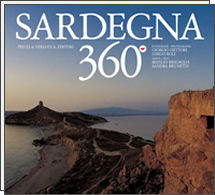In grande formato la Sardegna come non l’avete mai vista. Con immagini che si aprono fino a 2 metri
 Se chiedete a cento sardi com’è la Sardegna, novanta vi risponderanno che la Sardegna è diversa. Inutile obiettare che, a suo modo, ogni paese del mondo è diverso. La sensazione di una diversità fa parte integrante dell’immagine che i sardi hanno di sé e della propria terra. A giustificarli ci sono la geografia e la storia. La geografia: la Sardegna è un’isola, e l’insularità marca fortemente il destino di ogni isola e agisce robustamente, nei secoli, sul carattere della gente che ci abita. Se chiedete a cento sardi com’è la Sardegna, novanta vi risponderanno che la Sardegna è diversa. Inutile obiettare che, a suo modo, ogni paese del mondo è diverso. La sensazione di una diversità fa parte integrante dell’immagine che i sardi hanno di sé e della propria terra. A giustificarli ci sono la geografia e la storia. La geografia: la Sardegna è un’isola, e l’insularità marca fortemente il destino di ogni isola e agisce robustamente, nei secoli, sul carattere della gente che ci abita.
La Sardegna è la più «periferica» delle isole del Mediterraneo, in particolare del Mediterraneo occidentale. Il canale che divide la Sicilia dal continente è una manica di lago, ma per la Sardegna la costa più vicina è addirittura quella africana: da Capo Teulada a Biserta ci sono centocinquanta chilometri, ce ne sono duecentotrenta da Olbia alla costa tosco-laziale, trecentocinquanta fra la Gallura e la Liguria, cinquecento fra Alghero e le coste di Catalogna. Così l’insularità porta anche isolamento. Lucien Febvre insegnava tanto tempo fa che ci sono due tipi di isole, l’isola-carrefour e l’isola-conservatoire. L’isola-crocevia è quella in cui le correnti della civiltà s’incontrano e magari anche si scontrano, ma animando un’accelerazione delle culture che vi si sono insediate; l’isola-deposito resta ai margini di queste grandi correnti, che la lambiscono alla lontana, anzi quasi la evitano, sicché i tempi della storia vi si depositano come una lenta polvere. La Sicilia è un’isola-crocevia, la Sardegna un’isola-deposito, diceva lui stesso.
Oggi la distinzione non è, secondo molti, così netta. Non sempre la Sardegna è stata così isolata come si pensa, anzi il mare - che i sardi non amano, diceva un vecchio luogo comune di antropologi e geografi - ha agito spesso collegando l’isola al resto del mondo, facendo approdare alle sue rive navigatori, mercanti, esploratori, soldati, imprenditori avventurosi che hanno portato ciascuno il loro granello di novità, la loro piccola lezione. A cominciare da quei fenici che, sbarcando sulla costa di Nora nei secoli iniziali del primo millennio avanti Cristo, segnarono su una pietra un grumo di lettere che gli scienziati leggono come il primo nome della Sardegna.
[..] |
 If you ask a hundred Sardinians what Sardinia is like, ninety will tell ou is it different. It's a waste of time to point out that every country in the world is different after its own fashion. The feeling of diversity is part and parcel of the image the people of Sardinia have of themselves and their land. Both history and geography are on their side. Sardinia is an island. Insularity leaves a deep mark on destiny of every island and firmly moulds the character of its inhabitants over the centuries. If you ask a hundred Sardinians what Sardinia is like, ninety will tell ou is it different. It's a waste of time to point out that every country in the world is different after its own fashion. The feeling of diversity is part and parcel of the image the people of Sardinia have of themselves and their land. Both history and geography are on their side. Sardinia is an island. Insularity leaves a deep mark on destiny of every island and firmly moulds the character of its inhabitants over the centuries.
Sardinia is the most peripheral of the Mediterranean's islands, especially those in its western half. The channel that
separates Sicily from the continent is but the sleeve of a lake, whereas the nearest coastline to Sardinia is that of Africa: the
distane from Cape Teulada to Biserta is 150 kilometres, whereas there are 230 between Olbia and Tuscany, 350 between
the Gallura and Liguria and a full 500 between Alghero and Catalonia. Many years ago, the French historian Lucien
Febvre taught us that there are two types of island the "ìle-carrefour» and the "ìle-conservatoire». A carfax island is one
where the currents of civilisation meet and maybe clash, but spur the progress of the local cultures, whereas a conservatory
island is set apart from these great currents, whose waves barely kiss or even seem to avoid its shores, so that the dust of history accumulates thereon in slowly formed layers. Sicily is of the first type, Sardinia the second, as Febvre himself declared.
There are many today, of course, who bold that this distinction is not so sharp as it was. Sardinia has not always been
so i solated as people think. The sea, indeed, no paramour of the locals according to an old saying repeated by anthropologists and geographers, has often joined the island to the rest of the world and brought to its shores navigators, merchants, explorers, soldiers and venturesome entrepreneurs, each bearing a grain of something new, each with a lesson to teach.
Phoenicians, for example, who landed on the Nora coast in opening centuries of the first millenium B.C. and left on a Stone a gobbet of letters regarded by epigraphists as the first name of Sardinia.
|


G. Dettori - G. Roli - M. Brigaglia - S. Brunetti
SARDEGNA 360? sp
editore PRIULI & VERLUCCA
edizione 2010
pagine 142
formato 34,5x31
cartonato con sovracoperta plastificata a colori, con fotografie che si aprono a 2, 4, 6 ante (fino a 2 metri di lunghezza)
tempo medio evasione ordine
ESAURITO
45.00 €
45.00 €
ISBN : 978-88-8068-479-4
EAN : 9788880684794
|
|